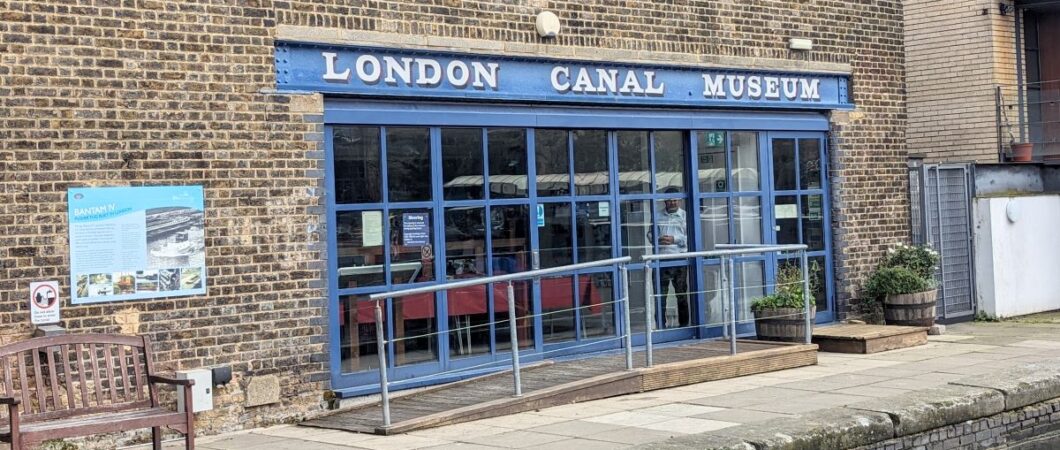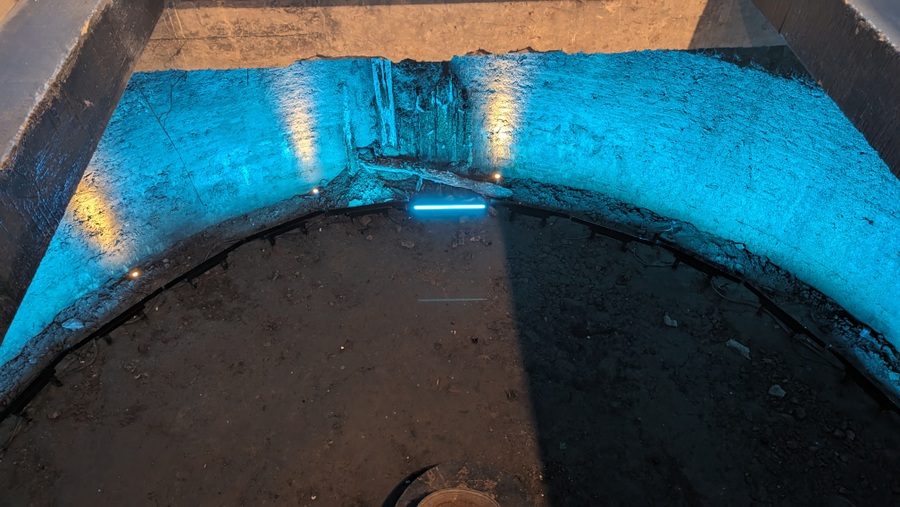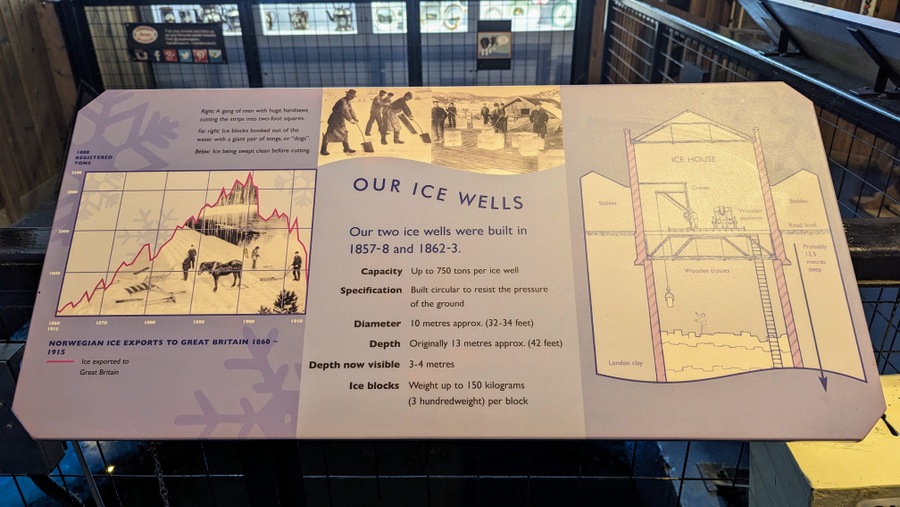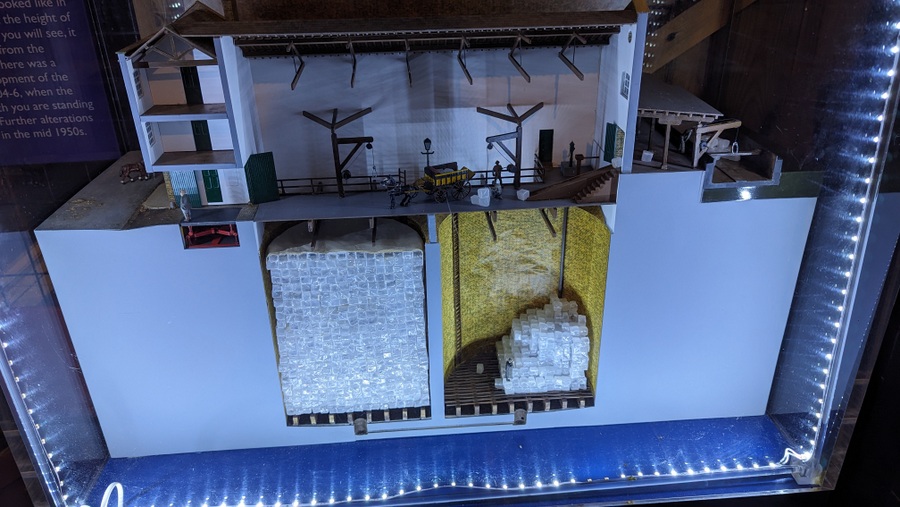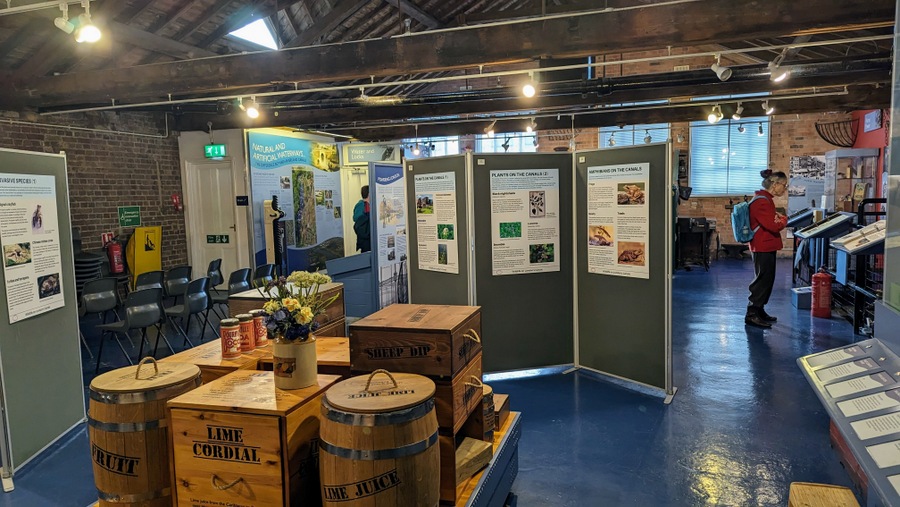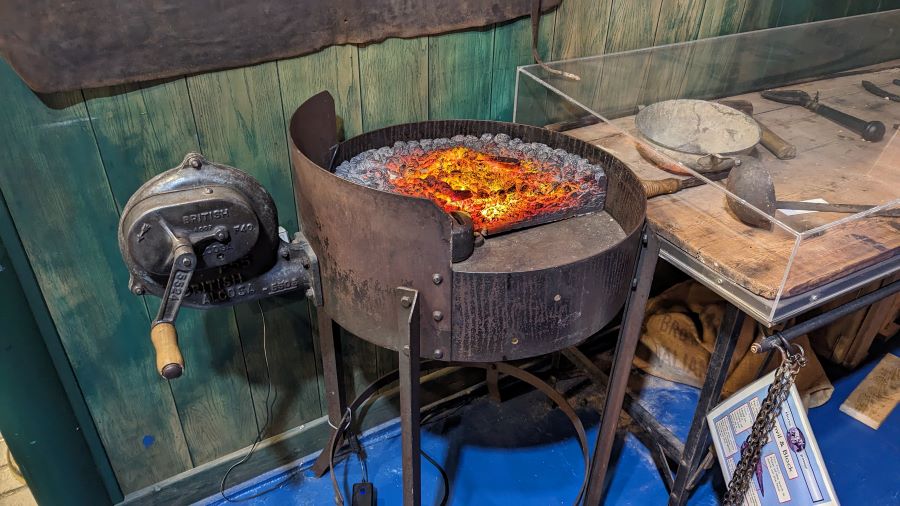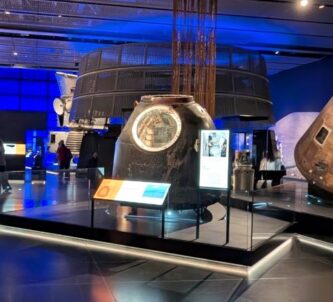The London Canal Museum (LCM) is housed in an historic canal warehouse, just north of King’s Cross. It has displays and artefacts on two floors, telling the story of canals, and London’s canals in particular, from their construction, the goods and industries that relied on them for transport, the lock keepers, boatmen and their families who worked on them, the boats themselves, and the means of propulsion from horses to engines.
The museum building itself, now surrounded by modern apartments, was a specialised warehouse built in 1858 on Battlebridge Basin for the well-known restaurant owner and ice cream maker, Carlo Gatti. It was an ice store.
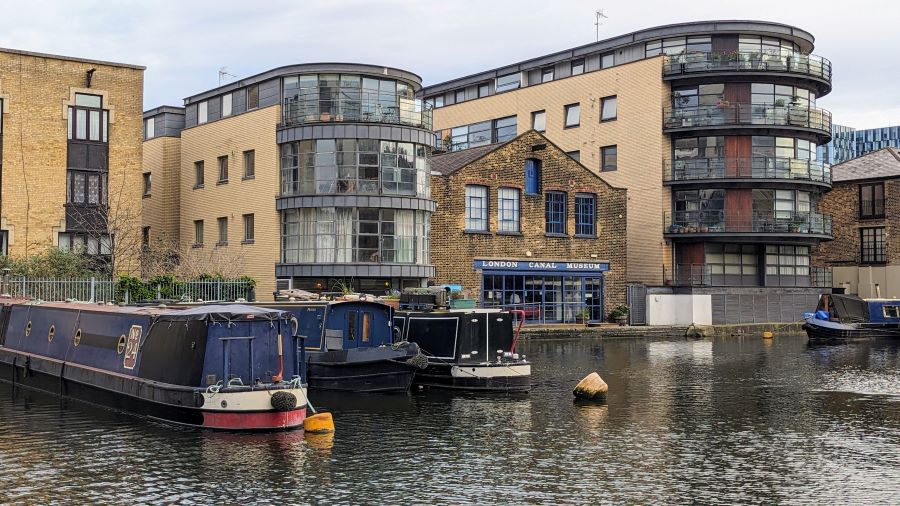
In the century between 1820 and 1920 (when mechanical refrigeration took over), ice was carved from lakes and glaciers in Norway, cut into 2ft square blocks, shipped across the North Sea and up the Thames to London where it was used extensively by fishmongers, butchers, restaurants and other food trades, including ice cream makers. It was big business. The museum building had two deep ice wells that could each store up to 750 tons of ice.
One of those ice wells has been opened up so visitors can see into it.
You don’t even have to visit the museum to see it. They have a controllable ‘live’ webcam (Ignore the non-https warning) set up between both ice wells so you can can spin the camera around and view either! To be honest…. it’s not the most exciting livestream you’ll ever watch, but there you are!
On the Canal Museum Ground Floor
The ground floor has some of the museum’s larger exhibits, like a narrow Wickham Diesel Tractor, designed for tow paths, and a cutaway ‘monkey boat’ which enables visitors to see just how cramped conditions on board could be.
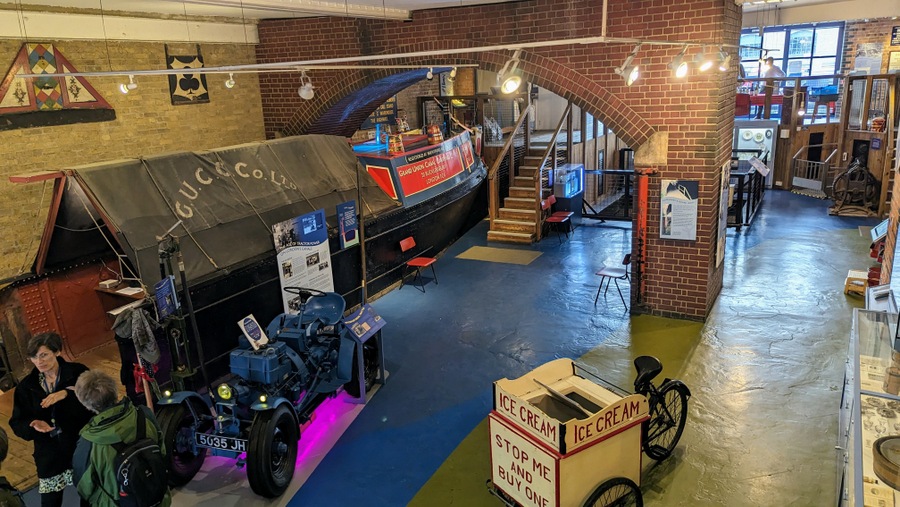
The standard size for a canal boat, as defined by canal engineer James Brindley who started designing narrow locks in the mid-eighteenth century, was 70 ft by just 7 ft wide, hence “narrowboat”. These boats were usually operated by a boatman and a boy… and a horse. But as railways began to offer more and more competition to the canals, wages stagnated and it became increasingly hard for boatmen to keep a family home, so they started bringing the whole family with them, and designed tiny little cabins – not taking up too much precious cargo space – for them to live in.
It is thought that the local London nickname, ‘monkey boats’ came from the boat builder Thomas Monk, who was the first to start producing narrowboats with cabins.
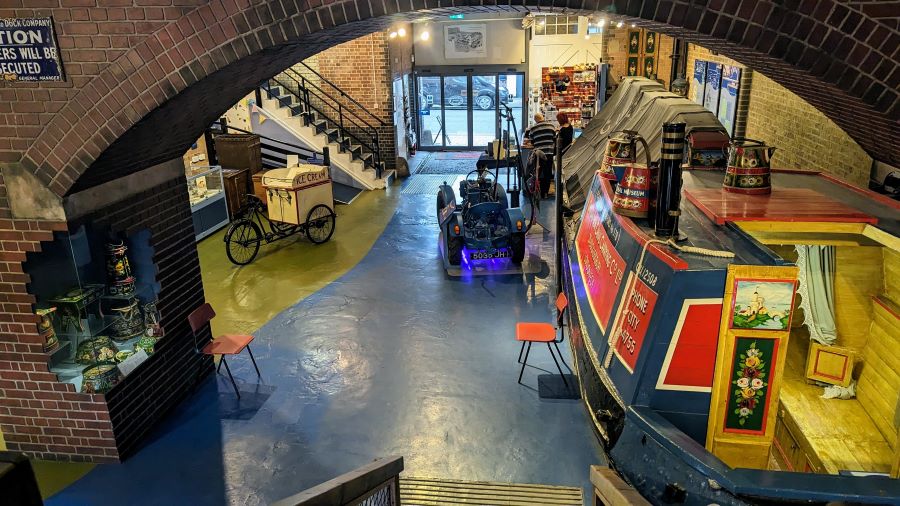
At the far end of the ground floor, past the ice wells, is the door onto the canal side wharf, where the museum’s small 1949 canal pusher tug, Bantam IV is moored (not just at the moment – May 2025 – she’s away for a refit), and where the museum’s day trips are operated from.
On the Canal Museum First Floor
Upstairs, the museum uses archive film, info boards, historic photos, models, and oral history recordings from people who recall the working days of the canals, to explain to visitors how canal systems like locks function; types of canal barges and the cargoes they carried; and traction from horses to diesels.
Something I didn’t know; pulling heavy barges by horse is not easy. Once underway, barges have a lot of momentum, and tow ropes can get mixed up with other barges. It wasn’t unusual for horses to get dragged into the water… which is why, in London at least, there are numerous ramps built into the canal so horses can get back out.
‘Blow up Bridge’
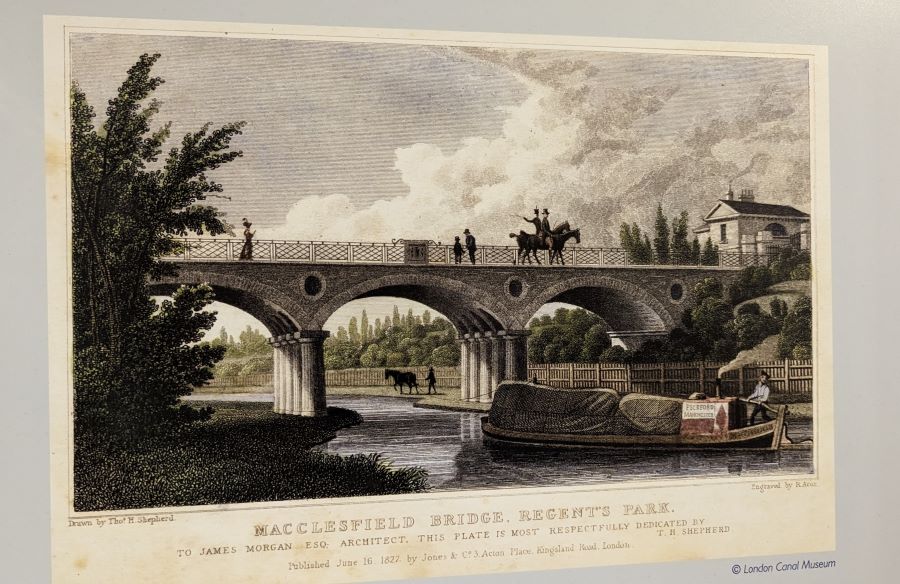
One thing that caught my eye was the report of ‘Blow up Bridge’ on the Regents Canal – an event I’d never heard of, which is surprising because it was a notorious disaster.
In the early hours of 2 October 1874, a line of six barges were being towed by a steam tug westward along the Regent’s Canal as it loops around Regent’s Park. The third barge, named ‘Tilbury’ with reportedly three boatmen and a boy on board, was carrying a cargo of coffee, sugar, nuts, 2 or 3 barrels of petroleum… and five tons of gunpowder!
Just before 5.00am, as it passed under the Macclesfield Bridge, it is thought one of the crew maybe struck a match to light his pipe or something – nobody knows – and the fumes from the petroleum ignited causing a colossal explosion.
The barge and its crew were vaporised, the bridge was destroyed, and another barge sank. Nearby houses were destroyed or badly damaged, windows as far away as St. John’s Wood were shattered, and people all over London were rudely woken from their sleep. Not surprisingly it caused panic among the animals in London Zoo next door. Indeed the chaos and confusion was so great, a detachment of Horse guards from nearby Albany Barracks were brought in fearing the explosion was the work of Irish Republicans. They helped to help restore order and allay fears of animals escaping from the zoo.
The underside of the Georgian bridge had absorbed most of the blast, leaving the cast iron pillars intact, but the area was a shambles, covered in bricks, rubble and dead fish.
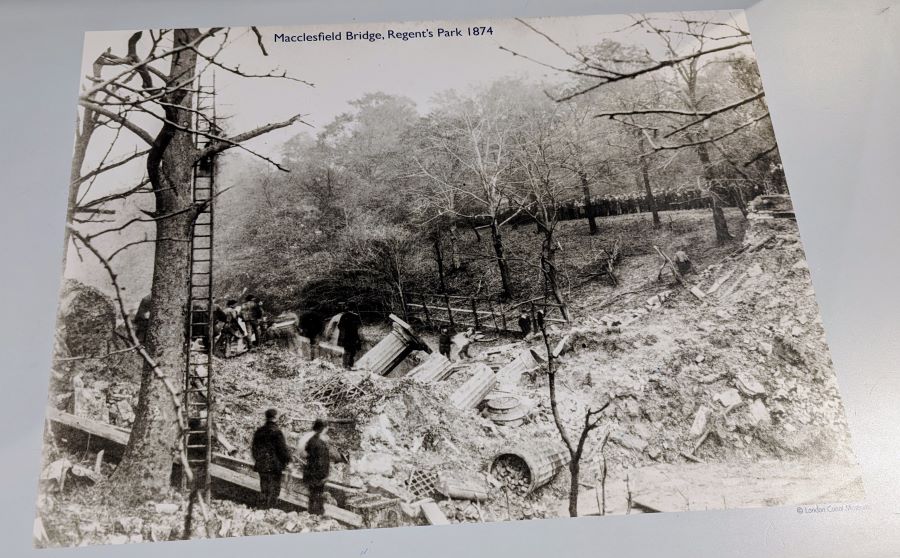
This was certainly a wake-up call! The Times newspaper quickly pointed out: “This explosion has revealed the fact that London has for years been traversed in some of its most populous and wealthy quarters by fleets of torpedoes.” I suspect it was the ‘wealthy quarters’ bit that Parliament particularly noticed because a year later it passed The Explosives Act 1875, which amended the law with respect to manufacturing, keeping, selling, carrying and importing Gunpowder, Nitro-glycerine and other explosive substances.
Macclesfield Bridge was rebuilt in 1876 using those ten original iron columns, but there’s an interesting ‘twist’. They were turned around so the groove marks from years of boatmen’s ropes being tied and untied around them were now on the inside. If you visit the bridge today you will see they are complimented by rope grooves on the outside of the columns.*
Canal Boat Trips on the Regent’s Canal

The museum also offers canal boat trips on the Regent’s canal, run in collaboration with the nearby Angel Community Canal Boat Trust (ACCT) using their jointly-owned 45 ft narrowboat named ‘Long Tom‘, which can carry 12 passengers in a glass enclosed cabin.
Long Tom is based at the LCM in Battlebridge Basin and, during the summer season, spends half the week operating short trips (25 mins – 90 mins), and longer day trips eastbound to Victoria Park and westbound to Little Venice.
One of the most popular short trips passes through the nearby Islington Tunnel, which separates the two organisations (LCM & ACCT). It is 960 yards (0.88 kms) long and takes 20 minutes to navigate in each direction.
Boat trip tickets include entry to the museum, and, except on the short 25 min trips, a guide/narrator for the trip.
Future Development at the London Canal Museum
The museum now has planning permission for a new pontoon in Battlebridge basin which will be the home of an 1898 horse-drawn cargo canal boat that the Canal & River Trust are giving to the LCM as a floating exhibit.
And at some point, they hope to replace Long Tom with a more environmentally-friendly electric boat.
* Barge ropes were usually made of cotton and didn’t last very long. Trailing in the water they became sodden and covered in grit, which is why they carved grooves so easily in every cast iron bollard, ring or pillar.
Declaration: I was on a press visit. Museum entry was complementary.
Factbox
Website:
London Canal Museum
Getting there: London Canal Museum
12-13 New Wharf Road
London
N1 9RT
Boat Trips (2025) There are five itineraries…
- Tunnel boat trip. From the museum through Islington Tunnel, three-quarters of a mile long, and back. Approx. 50 minutes. Available on Thursdays and Sundays.
- Long trips to Little Venice in west London via St. Pancras, Camden locks, Regent’s Park, and the Maida Hill Tunnel. Departs 1115 on alternate Fridays, and takes around two hours each way.
- Long trips to Victoria Park (Bethnal Green). Departs 1115 on alternate Fridays. The trip takes about two hours outward and 90 mins for the return journey which terminates at Islington near Angel Underground station.
- Cream Tea cruises. Every Thursday afternoon. The 90 min trip, with traditional cream tea, passes through the Islington Tunnel and the City Road Lock before returning to the museum.
- Camden Locks Explorer. Departs 1115 on selected Wednesdays in the summer season. The trip passes through four locks to the west of Camden, and returns. It lasts around three hours with tea/coffee served on board.
Boat trip dates, details and booking here.
Prices (2025):
| Adults | Concessions | Children (0-15) | |
|---|---|---|---|
| Museum only ** | £ 7.50 | £ 6.00 | £ 3.75 |
| Tunnel Trip * | £ 17.00 | £ 15.00 | £ 11.00 |
| Long Trips * | £ 32.00 | £ 30.00 | £ 25.00 |
| Cream Tea Trip * | £ 26.00 | £ 24.00 | £ 19.00 |
| Camden Locks Trip * | £ 24.00 | £ 22.00 | £ 18.00 |
* Trip tickets include museum entry
** Museum family ticket £ 15
Museum Opening Hours (2025):
Tuesdays to Sundays, 1000 to 1630 (last entry 1600).
The museum is closed on Mondays, except bank holidays. See website for Christmas-New Year dates.

